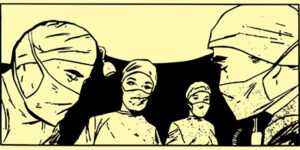Dynamic Art: The Use of Natural Features to Capture Animal Movement and Dimensions in Ice Age Cave Art.
Wandering into the cave to seek refuge during the harsh conditions of the last ice age, a person observes otherworldly features emerging under the dim glow of their torch. Under the flickering light cast by the flame, dancing shadows tease at their perception, and images of animals seem to flicker in and out of focus. Inspired, they reach for some pigment and smear it across the cave wall, capturing the form of the animal they briefly glimpsed.
Ice Age cave art emerged at least 70,000 years ago in the Middle Palaeolithic within our closely related cousins, the Neanderthals (Homo sapiens neanderthalensis), and our own species (Homo sapiens sapiens) appear to engage in this practice from the start of the Upper Palaeolithic, around 40,000 years ago. Cave art became widespread during this period and it is an intriguing form of visual culture; the decision to venture into dark and dangerous caves to make art is one that still perplexes archaeologists. It is one of the earliest and most unique examples of a fundamental human characteristic: the desire to create. By better understanding it, we can unpick how this desire emerged in our species.
It is one of the earliest and most unique examples of a fundamental human characteristic: the desire to create.
Set in Stone
One way to understand this behaviour is to explore the motives behind the placement and animal themes of the art. Cave art is overwhelmingly dominated by depictions of prey species (e.g. horse, deer, bison, and mammoth), that humans would have relied upon hunting, to survive harsh climatic conditions. However, the way these animals were depicted was not like how we might draw an animal today – i.e. as a static, two-dimensional image on a blank canvas. Instead, our Palaeolithic artists seemed to utilise the natural features of the cave to capture the image and dimensions of an animal. Cracks in the wall may be used to represent the back of an animal, or a contour might be used to represent an animal’s leg (Figure 1).
Figure 1. Depiction of a bison from El Castillo cave (Cantabria, Spain). The back and tail of the animal is represented by a natural crack in the wall, and this crack also forms the horns of another bison. Image: Author / Gobierno de Cantabria ©
There are several theories as to why animal depictions seem to utilise the cave wall in this way. One, spearheaded by the psychologist Derek Hodgson (2006; 2008; 2012; Hodgson and Pettitt 2018), proposes that the nature of cave environments had a specific effect on Palaeolithic people’s visual system. The darkness and dim flickering light of a flame would have heightened the sensory awareness of these Palaeolithic explorers, and in the darkness their visual system would try to “make sense” of the limited visual information it was receiving. This would have triggered a psychological response known as hyper-imagery (Hodgson 2008, 344), where unfamiliar and suggestive visual cues suddenly look like something else – similar to when you wake suddenly in the night and mistake a coat hanging on a door for a person.
Hodgson proposes that under these conditions, the suggestive shapes of rocks might have looked like animals to Upper Palaeolithic people exploring the cave. Upon seeing these familiar animals, they decided to trace its form using natural pigments as paint, or a stone tool to carve the form into the wall. This would suggest that some aspects of the theme and placement of these depictions were predetermined, or set in stone, and our Palaeolithic artists were merely at the mercy of their own visual system.
Bringing the Art to Life
This effect of cave environments on the visual system as an explanation for the relationship between natural features and cave art, perhaps does not tell the whole story. If we consider this in more depth, the response of pausing to paint animals that you see in an eerie cave doesn’t quite make sense – we would probably all agree the most natural response to seeing animals emerging from rocks would be to run out of the cave!
Instead, it is more likely this phenomenon took on a certain cultural significance and was the inspiration, rather than the sole impetus, for creating art within caves. Animals were culturally important to Upper Palaeolithic people, both as crucial resources of food and materials and as central partners in their lives, allowing these people to think with and about their place in the world. Unsurprisingly, the artistic repertoire of Upper Palaeolithic societies involves animals in multiple ways; animal forms were carved out of ivory, engraved on antler and stone, and parts of animals were used as jewellery. Thus, it is likely that seeing these animals emerge from suggestive features in caves would have evoked a deep-rooted importance of animals to human societies, and consequently capturing their form took on a rich cultural meaning.
Animals were culturally important to Upper Palaeolithic people, both as crucial resources of food and materials and as central partners in their lives, allowing these people to think with and about their place in the world.
The positioning of animals within cave art reflects the attentiveness of humans to animals during this period. The animals are not depicted as static or passive; instead, they are represented in a way that captures the behaviour of an animal as alert, grazing, resting, mating, and much more. By utilising cracks or contours, the image of the animal is transformed into a 3-dimensional representation. Remarkably, even the flickering light of a Palaeolithic torch plays a role in bringing the art to life. In some instances, animals are depicted with multiple heads or legs in different positions, which appears to intentionally animate the animal (Azéma and Rivère 2012); under a flickering light, one sees one head position, then the other, giving the impression of movement (Figure 2).
Figure 2. The panel of the lions in Chauvet cave (Ardèche, France). Some of these cave lions have been depicted with multiple heads and legs, to give the impression of movement when viewed under a flickering light. Image courtesy of Wikimedia Commons.
Cave art encapsulates the creative, and distinctly human, capabilities of our species. For our ancestors, cave art was a medium through which they negotiated their relationship with the natural world around them; art was an active process, deeply embedded in the tempos of Upper Palaeolithic social life. Art was, and continues to be a medium through which we seek to understand ourselves and the world around us.
Izzy Wisher is an archaeologist, specialising in interdisciplinary approaches to Palaeolithic art. She is currently a postdoctoral researcher at Aarhus University (Denmark), working alongside cognitive scientists on the ERC project eSYMb: The Early Evolution of Symbolic Behaviour. She completed her PhD in 2022 at Durham University (UK), where she used virtual reality and methods from psychology to understand how pareidolia – the phenomenon of seeing forms in random patterns, like faces in clouds – influenced the production of Upper Palaeolithic cave art in northern Spain.


